Legrand Bundle
Who Really Owns Legrand?
The ownership structure of any company is a key factor in understanding its strategic direction and market performance. Legrand, a global leader in electrical and digital building infrastructures, has a fascinating ownership history that has shaped its evolution since its founding in 1865. Understanding the dynamics of Legrand SWOT Analysis and its ownership provides crucial insights into its strategic resilience and commitment to innovation.
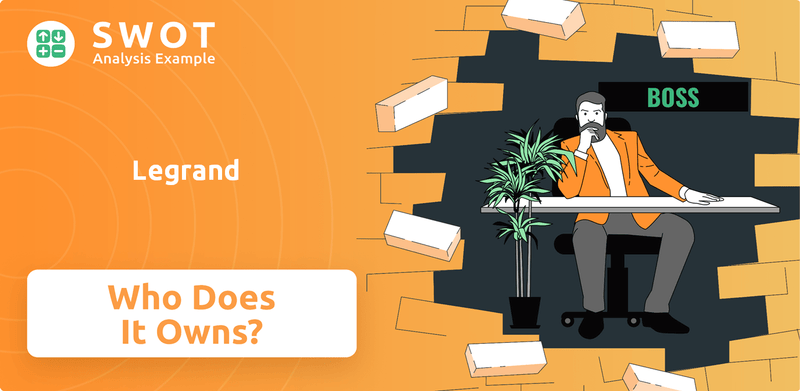
From its humble beginnings as a porcelain workshop to its current status as a Euronext Paris-listed company, Legrand's ownership has undergone significant changes. This exploration will delve into the details of Legrand's ownership, including its major shareholders and the influence of its board of directors. Knowing the Legrand parent company and the Legrand company ownership structure is vital for anyone looking to understand its market position and future prospects, including details on the Legrand headquarters and its subsidiaries.
Who Founded Legrand?
The story of the Legrand company begins in 1860, rooted in a small porcelain studio in Limoges, France. Initially focused on tableware, the business evolved through several ownership changes before transforming into the global electrical equipment giant it is today. Understanding the early ownership structure of Legrand provides crucial context for its later strategic decisions and market position.
The evolution of Legrand's ownership reflects a series of transitions, from its origins in porcelain manufacturing to its specialization in electrical fittings. Key figures and pivotal moments shaped the company's direction, including the shift from tableware to electrical components, and the influence of family ownership.
The early ownership of Legrand highlights the company's adaptability and strategic shifts. This journey from a small porcelain studio to a global leader in electrical equipment reveals how ownership changes and market opportunities have shaped Legrand's trajectory over the decades.
In 1860, Mr. Barjaud de Lafont established a porcelain tableware studio in Limoges, France. This marked the initial phase of the company's existence, focusing on a different product line than its current electrical offerings.
The Vultry brothers took over the business in 1865, continuing the focus on porcelain tableware. This period represents a transition in management but maintained the original product line.
Frédéric Legrand acquired the business in 1904, and the company was renamed Legrand, Alary & Joquel Company. This marked a significant change as the company adopted the Legrand name.
By 1911, the company's name changed to Betoule Legrand & Co., with Emile Betoule and Frédéric Legrand at the helm. This reflected a shift in leadership and potentially strategic direction.
In 1919, Jean Mondot partnered with the company to start producing electrical fittings using porcelain. This was the beginning of Legrand's diversification into electrical equipment.
The company was incorporated as a 'société anonyme' (SA) in 1926. This move reflected a change in the company's legal structure, which is a common step for companies expanding their operations.
The 1944 acquisition by Jean Verspieren and Edouard Decoster, brothers-in-law, marked a pivotal moment. This change led to the complete shift of focus to the electrical fittings business, abandoning porcelain manufacturing by 1950. The Verspieren and Decoster family's continued ownership, with over 42% of the stock in 1996, underscores the long-term family influence on Legrand's strategic direction. This family control significantly shaped the company's growth and strategy over several decades, influencing its global expansion and product innovations. As of 2024, Legrand's market capitalization is approximately $25 billion, reflecting its strong position in the electrical industry. The company's headquarters are located in Limoges, France, the same city where it was founded. Legrand has multiple subsidiaries, including those acquired through strategic acquisitions to expand its product offerings and market presence.
- 1860: Founding of the porcelain studio in Limoges, France.
- 1919: Diversification into electrical fittings begins.
- 1944: Acquisition by Jean Verspieren and Edouard Decoster.
- 1996: Family ownership of over 42% of the company stock.
Legrand SWOT Analysis
- Complete SWOT Breakdown
- Fully Customizable
- Editable in Excel & Word
- Professional Formatting
- Investor-Ready Format
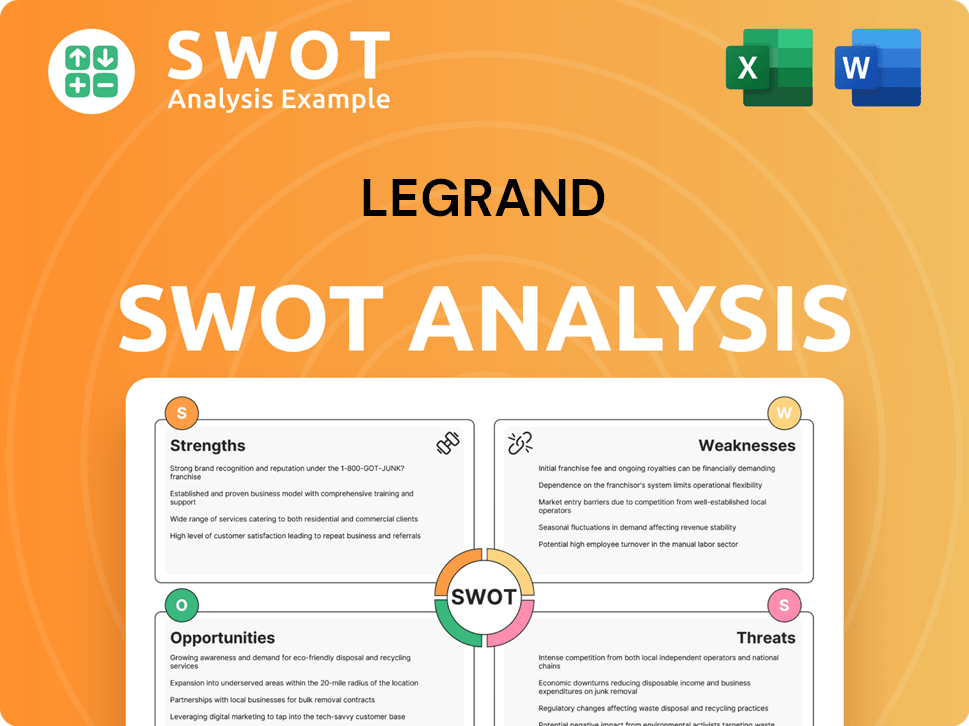
How Has Legrand’s Ownership Changed Over Time?
The evolution of Legrand's ownership reflects a journey from family control to a publicly traded structure. Initially listed on the Paris stock exchange in 1970, the company experienced a significant shift in 2001 when Schneider Electric attempted a takeover, acquiring up to 98.1% of the capital. However, this acquisition was blocked by the European Commission due to competition concerns, leading to Schneider's divestiture of its shares.
Following this, investment funds KKR and Wendel Investissement acquired the shares in 2003, resulting in Legrand's delisting. The company was re-listed on Euronext Paris on April 6, 2006, with an issue price of €19.75. KKR and Wendel Investissement remained majority shareholders after the re-listing. This transition highlights the impact of regulatory decisions and investment strategies on the company's ownership.
| Event | Year | Impact |
|---|---|---|
| Initial Public Offering | 1970 | Listed on the Paris stock exchange |
| Schneider Electric Takeover Attempt | 2001 | Acquired up to 98.1% of Legrand's capital; blocked by European Commission |
| Acquisition by KKR and Wendel Investissement | 2003 | Delisting from the stock exchange |
| Re-listing on Euronext Paris | 2006 | Re-entered the public market |
As of May 2025, Legrand's share capital consists of 262,245,733 shares. Major institutional shareholders, as of late 2024 and early 2025, include Massachusetts Financial Services Company (5.4%), Fidelity International Ltd. (5.01%), The Vanguard Group, Inc. (4.06%), and BlackRock, Inc. (3.74%). Other significant investors include JP Morgan Asset Management (2.43%), T. Rowe Price Group, Inc., Baillie Gifford & Co., Schroder Investment Management North America Inc., and Goldman Sachs Asset Management, L.P. The Legrand Employee Stock Ownership Plan holds 1.38% of the capital. This demonstrates a diversified ownership structure, typical of a large public company.
The ownership of the Legrand company has transformed significantly over time.
- From family control to a publicly traded entity.
- Major institutional investors hold significant stakes.
- The current structure reflects a diversified ownership base.
- The company's history includes significant events impacting ownership.
Legrand PESTLE Analysis
- Covers All 6 PESTLE Categories
- No Research Needed – Save Hours of Work
- Built by Experts, Trusted by Consultants
- Instant Download, Ready to Use
- 100% Editable, Fully Customizable
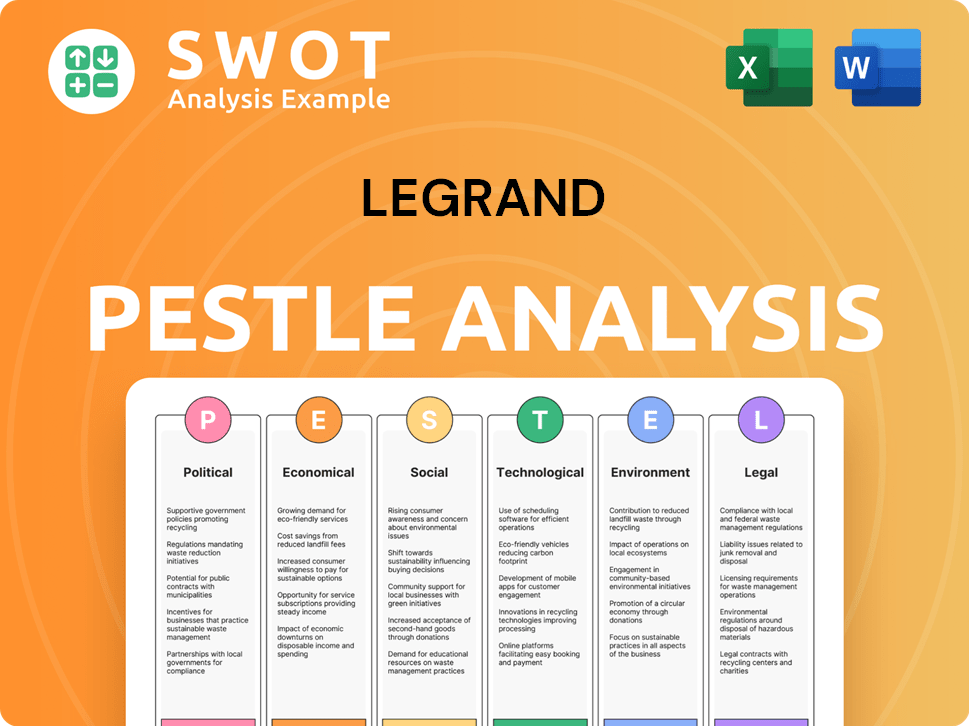
Who Sits on Legrand’s Board?
The governance of the Legrand company is overseen by a Board of Directors, which is crucial for setting strategic direction and ensuring its execution. As of May 27, 2025, the board comprises 13 members, including two employee representatives. The board emphasizes independence, with nine independent members, representing approximately 82%, surpassing the AFEP-MEDEF Code's recommended minimum of 50%. The board also highlights gender diversity, with six women (55%), and cultural diversity, with members from seven different nationalities. The board's composition includes six current or former Chief Executive Officers from major listed groups, bringing substantial experience to the company's strategic decision-making.
The company's structure ensures that shareholders are well-informed about the board's composition and activities. The corporate governance report, detailing the Board of Directors, was presented on March 19, 2025, at the Annual General Meeting held on May 27, 2025. This commitment to transparency is a key element of the company's approach to corporate governance. For further insights, you can review the Marketing Strategy of Legrand.
| Aspect | Details | Date |
|---|---|---|
| Board Composition | 13 members, including 2 employee representatives | May 27, 2025 |
| Independent Members | 9 members (82% of the board) | May 27, 2025 |
| Gender Diversity | 6 women (55%) | May 27, 2025 |
Regarding voting rights, Legrand operates on a one-share-one-vote basis for its ordinary shares. As of May 31, 2025, the total number of shares was 262,245,733, with exercisable voting rights totaling 261,656,830 after accounting for shares without voting rights. Slight variations in exercisable voting rights during early 2025 reflect adjustments related to shares temporarily stripped of voting power. There were no stock options exercised during Q1 2025 that would have altered the total share count. The Legrand company ownership structure is designed to ensure fair representation and transparency.
The Board of Directors at Legrand is structured for independence and diversity, ensuring robust governance. The voting structure is straightforward, with one vote per share, promoting shareholder participation. The company's commitment to transparency is evident in its reporting practices.
- Board composition includes a majority of independent directors.
- Voting rights are primarily based on a one-share-one-vote system.
- The company emphasizes transparency in its corporate governance reporting.
- The board includes current and former CEOs of major listed groups.
Legrand Business Model Canvas
- Complete 9-Block Business Model Canvas
- Effortlessly Communicate Your Business Strategy
- Investor-Ready BMC Format
- 100% Editable and Customizable
- Clear and Structured Layout
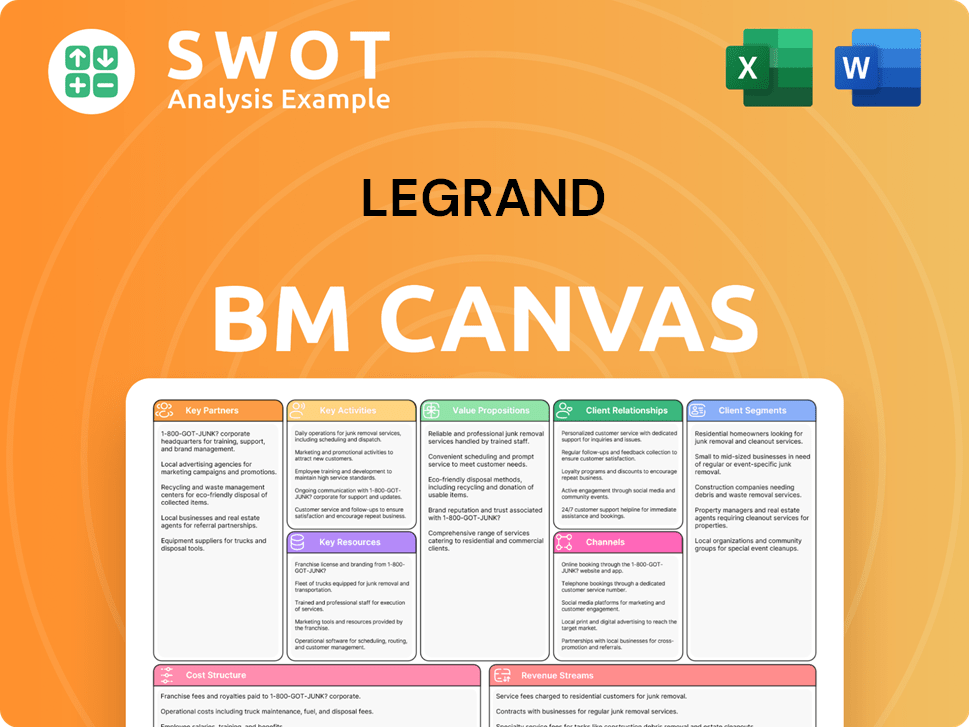
What Recent Changes Have Shaped Legrand’s Ownership Landscape?
In the past few years, the Legrand company has focused on strategic growth through acquisitions and innovation. The company's sales reached €8.6 billion in 2024, with a strong adjusted operating margin of 20.5%. A significant driver has been its datacenter business, which represented 20% of sales in 2024. The company is also committed to sustainability, as demonstrated by the acquisition of a majority stake in Circul'R in December 2024, a French circular economy consulting firm. These efforts are part of a broader strategy to enhance its market position and drive long-term value.
Legrand ownership has been influenced by mergers and acquisitions (M&A) and share buyback programs. In 2024, the company announced nine acquisitions, including five in the datacenter segment, totaling approximately €430 million in annual sales. The company plans to allocate €5 billion for M&A through 2030, averaging €800 million annually. In addition, Legrand has engaged in share buyback programs. Under an authorization from the General Meeting of Shareholders on May 29, 2024, Legrand signed a contract to repurchase a maximum of 475,000 shares (around 0.18% of its capital) between March 31, 2025, and May 16, 2025. A new share buyback program, authorized on May 27, 2025, allows for repurchases of up to 10% of the share capital until November 27, 2026.
| Metric | Value | Year |
|---|---|---|
| Sales | €8.6 billion | 2024 |
| Adjusted Operating Margin | 20.5% | 2024 |
| Datacenter Sales Contribution | 20% | 2024 |
| M&A Allocation (through 2030) | €5 billion | - |
| Share Buyback (May 2025 - Nov 2026) | Up to 10% of share capital | - |
Industry trends suggest increased institutional ownership and a focus on strategic growth areas like datacenters and energy transition solutions. The company's strategic roadmap for 2030 aims for sales growth between +6% and +10% (organic and acquisitions, excluding currency effects) and a stable adjusted operating margin compared to 2024. The company confirmed its 2025 full-year targets in May 2025, expressing confidence. For more insight into its origins, you can explore a Brief History of Legrand.
Legrand company is a publicly traded company. The ownership structure includes institutional investors and public shareholders.
Recent acquisitions include Linkk Busway Systems, Computer Room Solutions (CRS), and a majority stake in Circul'R, expanding its presence in datacenters and sustainability.
In 2024, Legrand reported sales of €8.6 billion and an adjusted operating margin of 20.5%, with the datacenter business being a significant growth driver.
The company aims for sales growth between +6% and +10% through 2030 and is focused on strategic areas like datacenters and energy transition solutions.
Legrand Porter's Five Forces Analysis
- Covers All 5 Competitive Forces in Detail
- Structured for Consultants, Students, and Founders
- 100% Editable in Microsoft Word & Excel
- Instant Digital Download – Use Immediately
- Compatible with Mac & PC – Fully Unlocked
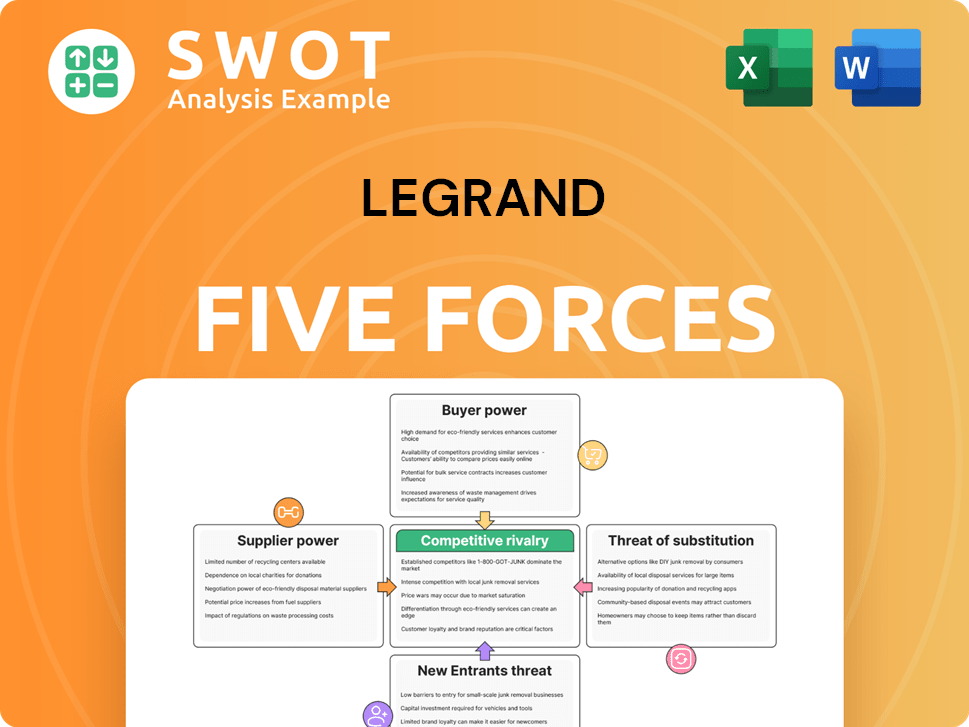
Related Blogs
- What are Mission Vision & Core Values of Legrand Company?
- What is Competitive Landscape of Legrand Company?
- What is Growth Strategy and Future Prospects of Legrand Company?
- How Does Legrand Company Work?
- What is Sales and Marketing Strategy of Legrand Company?
- What is Brief History of Legrand Company?
- What is Customer Demographics and Target Market of Legrand Company?
Disclaimer
All information, articles, and product details provided on this website are for general informational and educational purposes only. We do not claim any ownership over, nor do we intend to infringe upon, any trademarks, copyrights, logos, brand names, or other intellectual property mentioned or depicted on this site. Such intellectual property remains the property of its respective owners, and any references here are made solely for identification or informational purposes, without implying any affiliation, endorsement, or partnership.
We make no representations or warranties, express or implied, regarding the accuracy, completeness, or suitability of any content or products presented. Nothing on this website should be construed as legal, tax, investment, financial, medical, or other professional advice. In addition, no part of this site—including articles or product references—constitutes a solicitation, recommendation, endorsement, advertisement, or offer to buy or sell any securities, franchises, or other financial instruments, particularly in jurisdictions where such activity would be unlawful.
All content is of a general nature and may not address the specific circumstances of any individual or entity. It is not a substitute for professional advice or services. Any actions you take based on the information provided here are strictly at your own risk. You accept full responsibility for any decisions or outcomes arising from your use of this website and agree to release us from any liability in connection with your use of, or reliance upon, the content or products found herein.